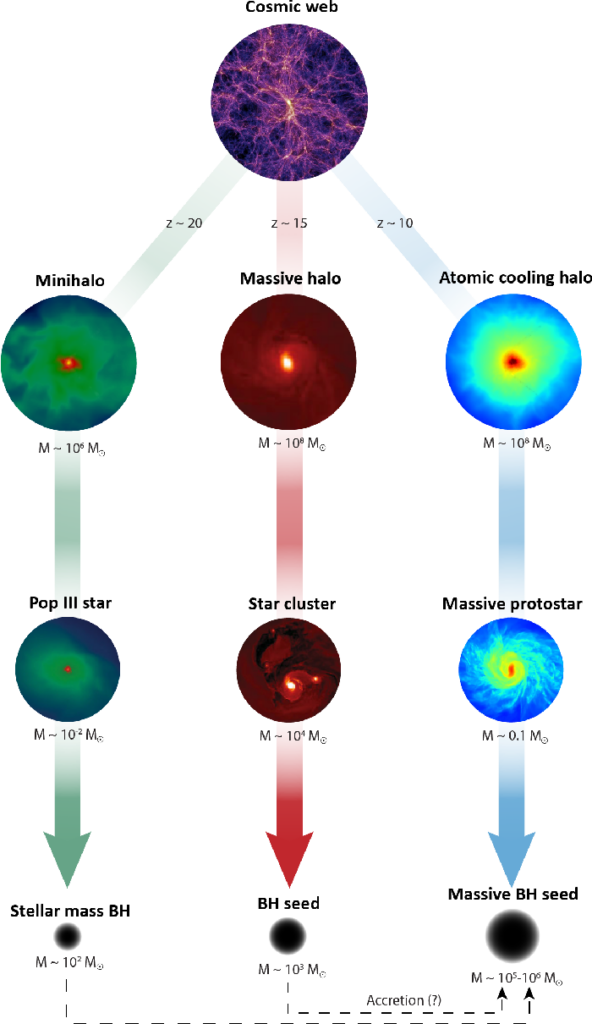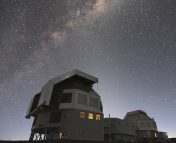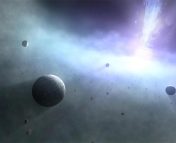Title: Massive Star Formation in Overdense Regions of the Early Universe
Author: John A. Regan
First Author’s Institution: CASM, Maynooth University, Ireland
Status: submitted to the Open Journal of Astrophysics [open access], available on the arXiv
In most of the larger galaxies we observe – like the Milky Way –, there seems to be a supermassive black hole (SMBH) at the center. These black holes are staggeringly massive (finally a self-explanatory name in astronomy, here’s a few examples of how not to), starting off at a million times the mass of the Sun up to billions of Solar masses. Here’s the problem: how did supermassive black holes get super massive? A lot of things can happen once a lot of time passes, and the universe has been around for quite a while. Still, astronomers are not sure how these black holes grew to such staggering masses. Moreover, already early on in the universe – even before its billionth birthday – there were SMBHs with over a billion Solar masses around. Currently, the general idea is that they are the product of mergers; smaller black holes melting together into larger ones until they reach the SMBH masses. The main problem is that it’s really hard to explain why this merging went so fast and hence why we see them at all.
How did we get here?
One of the more annoying things with black holes is that they tend to be hard to observe (unsurprisingly). Now, the black hole zoo is a diverse one. The ones we have observed already are the stellar mass black holes – the leftover dying stars (there’s a lot of them) – and the supermassive black holes, typically found at galactic centers – they’re very bright, or at least their surroundings are. There’s also the suspicion that so-called intermediate mass black holes exist, with masses between a thousand and a million solar masses. These merely Massive Black Holes (MBHs) are neither bright, nor are they abundant: they aren’t observed. While this is sometimes considered a red flag in astronomy, it is still believed that these objects are the key to understanding the formation of SMBHs.
There’s a whole wide range of explanations on how the MBHs form, with two main categories (see also Figure 1):
- Light seeds: a MBH grows from many standard Population III stars or their leftovers or can simply grow to huge masses by consuming a local very dense gas cloud.
- Heavy seeds: much heavier structures (order of at least a thousand solar masses) form and merge to MBHs.

The main problem with the light seed scenario is that there’s a maximum rate at which black holes consume matter: when matter drops into the black hole, the disk of material (= the accretion disk in scientific lingo) around it heats up and emits more and more light. At some point, the disk will become so bright that the sheer amount of light is so strong that it effectively keeps more material from falling in. When we reach a maximum amount of stuff falling into the black hole, anything more will just be stopped by the radiation from the disk. This is called the Eddington limit. It is this limit that limits (pun intended) the speedy formation of the MBHs in the light seed scenario: it simply can’t happen fast enough.
On the heavy seed side, it is harder to explain how these much more massive objects formed in the first place. But not impossible!
Superstars
To get the heavy seeds the MBHs need, the author of today’s paper looks towards supermassive stars (SMSs). As a very special case of Population III stars, they should be formed with hundreds of thousands of solar masses, a bit mind-blowing considering the stars we have today reach only a few hundred solar masses. Now there are two problems with Population III stars: they only occurred a very long time ago (so we need to look at huge distances) and they would have died off very quickly. So, sadly, we have not seen them yet.
These stars will, however, theoretically form in dark matter haloes in the early universe. Luckily, cosmological simulations are very good at that. For our SMSs, we need especially dense dark matter haloes to have any chance for them to form. Cosmological simulations are hardly easy, but a stage-wise zoom-in on structures of interest can reduce the effort. This is shown in Figure 2.

There, the author identifies an interesting overdense region. In the overdense region in Fig. 2, the author points at three clusters (aptly named C1, C2 and C3) which could hold the dark matter haloes where SMSs could have some chance of forming. This is still easier said than done however, as it seems there’s a bunch of conditions that we need to form these crazy stars:
- We need essentially almost zero ’metals’ in our haloes. This works best if no other stars have formed that spewed out harmful metals (in the astronomical sense of the word) which make it easier for low-mass stars to form and giving our SMSs no chance.
- We need a lot of material movement in the halo; the more local movement, the better this prevents clouds from collapsing early into smaller stars.
- The halo needs to form fast. The heat formed by the quick formation of the halo as it contracts must be higher than the radiative cooling of the material in the halo.
So, essentially we want to keep the lower mass stars from forming in order to get the monstrosity of a star we need to get a MBH. Analyzing these three clusters shows that at least C2 and C3 have dark matter haloes that can form SMSs. A rough estimate of star formation in these promising haloes show that some stars holding a hundred thousand solar masses could form – in the mass range of what we need for MBHs. These stellar behemoths would have been fairly rare due to their very picky formation requirements, but they could have been there.
As these SMS live their (very short, a few million years tops) lives, they will eventually collapse into fairly heavy black holes. Black holes that are right in the mass range we want for MBHs, so the SMSs serve well as heavy seeds for MBH formation. In any case, the possibility that these supermassive stars could have existed gets us one step closer to Massive Black Hole and eventual Supermassive Black Hole formation.
Astrobite edited by Katya Gozman
Featured image credit: Figure 15 c) from James et al. 2015




